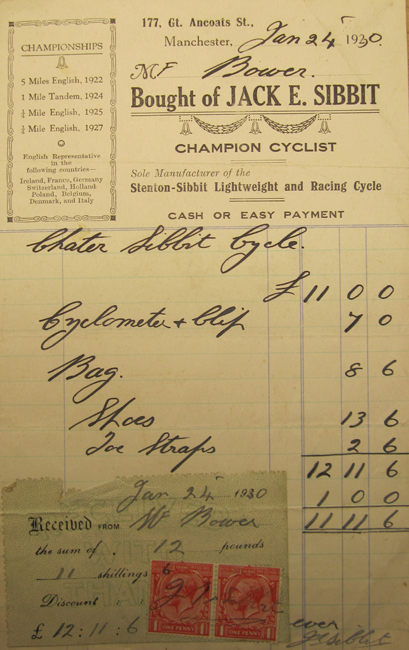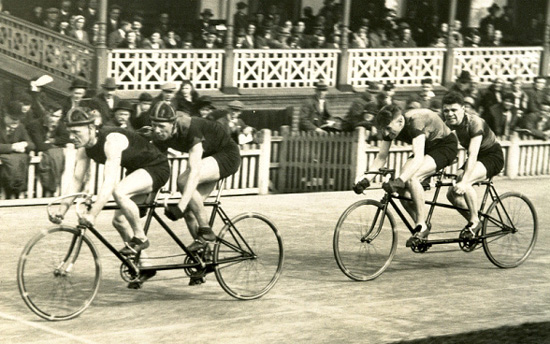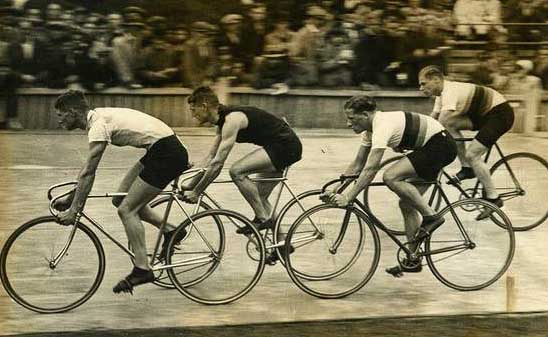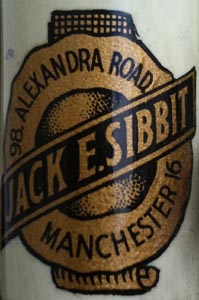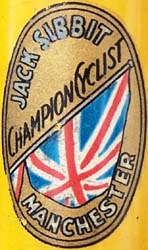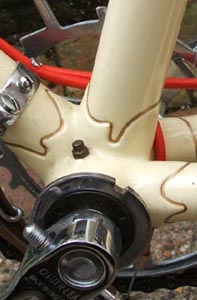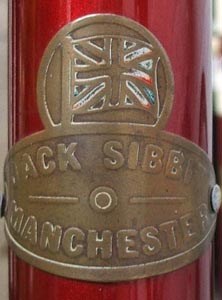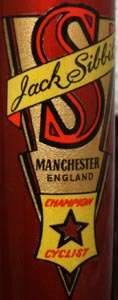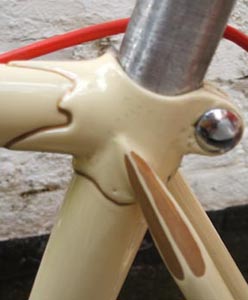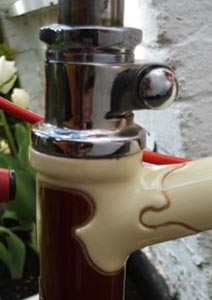Sibbit, J E
Posted: Friday 05th June 2020
John Ephraim Sibbit, born 1895, was the son of a Manchester butcher in Ancoats. He was cycling pre WWI and was conscripted to serve in the Royal Navy Air Service until he was demobilised in 1919 when he started cycling again. By the age of 41 he had held twelve National titles including Tandem sprints along with Dennis Horn. In 1931/32, uniquely as an amateur, he won the 1000-yards Sprint Championships.
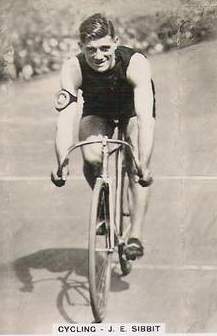
As a member of Manchester Wheelers, Jack Sibbit was a regular favourite at the Fallowfield track in Manchester but also rode track meetings the length and breadth of the country including Herne Hill in London. During his sprinting career Jack opened cycle shops Manchester and became well known for his frames and wheelbuilding. Being based in Manchester many of these frames and wheels would have been supplied to local track riders as they would have had confidence in someone with a record like Jack’s. He had shops in Great Ancoats Street (two different ones, one after the other) the first at 117 and the second at 177, Stockport Road and Alexandra Road. Presumably moving from one to the other as his trade increased although the last one was opened by his son after his death when the business was declining. See below for earlier history of his trading which has been unearthed.
He was conscripted to work in a local car manufacturing factory during the WWII years (1939-44) and resumed his business when released from this commitment. Some cycle shop owners managed to keep their shops open with the help of their wives but to date we have no record of this happening here. Sibbit did continue trading after the war in Stockport Road but he suffered a stroke in 1948 and died two years later when his son Jack Jnr took over the business eventually ceased trading in 1962.
I recently attended the 2010 Red Kite classic lightweights ride just outside Henley-on-Thames and was pleased to see a Jack Sibbit machine owned by Stuart Howe who lived nearby. A bonus was that Stuart had oral history back to the original purchaser who bought it from Jack Sibbit which traced this machine back to its manufacture in 1936. The transfers show the address, 98 Alexandra Road, Manchester but these would have been used when the frame was restored as they are not period correct. The frame also had an embossed brass headbadge of simple design:The frame was well-built and was very characteristc of the pre-war era.
In 1935, Cycling magazine announced that Jack Sibbit had opened a cycle shop in Manchester, “Jack Sibbit – 177 Gt Ancoats Street, Manchester – Specialist in Road, Path and Tandem Cycles” (see quote from Reg Harris below for more about this shop). This was the second shop he had in Great Ancoats Street (177), presumably larger, and it seems that Jack was relaunching his business with advertising and his contacts at Cycling gave him editorial coverage as they had reported his track exploits over many years. In 1936 Jack was still involved heavily in the world of track cycling. In those days most shop/business premises were rented and in the climate of the day it would be easy to move from one shop to another; he may even have used a wheelbarrow to transport stock and tools.
As well as the invoice above Andrew told us that he had been using the ‘classic lightweight’ website to date a Johnny Berry bike that came out of a cellar in Sheffield….a 1950 track frame later made up into an everyday bike with 3-speed Sturmey. The website was a great help and the photos brought back memories of going into Johnny’s shop in the early 60’s. I moved on to reading your info on Jack Sibbit . My father Geoff (born 1910) was a keen cyclist in his youth and purchased a Jack Sibbit bike in 1930 from 177, Gt Ancoats St. Since I have the original receipt I thought this would be of interest to you.

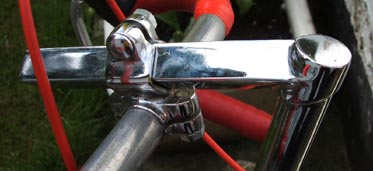
“I quickly found that I could learn a great deal from the experiences of the older members, and after a while I got to know Jack Sibbit quite well. He was a splendid old rough diamond who had had a very successful career as a cyclist which had brought him eleven British championship titles over various distances. He had also been an Olympic cyclist, but what impressed people most was that he did not stop racing until he was forty years old! They thought he was mad.” (Ironically Reg went on to win the National Professional Sprint Championship at the age of 54 years.)
“At this time Jack owned a small cycle shop in a poor area of Manchester called Great Ancoats Street. It was a very inadequately stocked shop, and it you bought two pairs of cotter-pins, the chances were that he would have to go round the wholesalers the next day get another two pairs. But he made superb bicycles in the kitchen behind the shop. As he rarely closed up before eight or nine in the evenings, I often used to ride down for chats with him and I learned a tremendous amount from him. After a while he began to follow my career very closely and I used to take his advice seriously. In some ways he was the closest thing to a coach I ever had, though I never let anyone officially be my coach – I usually preferred to do everything my own way. ”
MY TIME WITH JACK SIBBIT CYCLES IN THE POST-WAR YEARS
By Duncan Hamman
(Member of the Abbotsford Park RC. Manchester)
bikedunc(at)btinternet.com
When I was 15 years of age (during 1947) I joined a cycling club in the city of Manchester. This club was the South Manchester R.C.C. and my mum took me to Jack Sibbit’s bike shop on Stockport Road, Longsight, Manchester to buy me a new bike. I was very proud as we were served by the great man himself and I left the shop a very happy owner of a Jack Sibbit hand-built time trial bike. I thought it was wonderful. Every week I would join the other members of my club on their Sunday rides into the surrounding countryside, usually in the Peak District of Derbyshire.
About a year later I was scanning the newspapers looking for a job when I saw an advert in the Manchester Evening News for a youth to learn the cycle trade – what a wonderful opportunity this was for me. It was a dream job. I replied to the advert and was very surprised and delighted to discover that the job was to work at Jack Sibbit’s shop. At the interview I thought Jack was a bit overpowering and he seemed to have a short temper – I later discovered this was quite true, but I got the job.On my first day at work Jack snapped at me, “can you build wheels?” When I replied, “No” he replied “now’s your chance to learn.” He threw two rims, two hubs and a load of spokes onto the bench and with amazing speed built a wheel before my eyes. “Now you do it” he ordered and I did my best but got into a terrible mix-up. He was very short-tempered with my efforts and made me try again and again. I began to wish I had never applied for the job. I spent the rest of the day struggling with the wheels and got into an even bigger mess when I tried to build a front hub into a rear rim!
It took a long time but at last things started to come together and, after a lot of effort, I had built my first wheel. Then I spent the rest of the day building wheels but I wasn’t allowed to tension the spokes. As Jack explained to me the strength of a wheel was in the tension of the spokes and I wasn’t yet skilled enough to do the tensioning. During my first couple of weeks I must have built dozens of wheels and was later allowed to tension the spokes when Jack thought I had developed the necessary skills.
Another of my jobs every Friday was to clear out the shop window completely, clean everything, and replace all the bikes, frames and other stock. Also in the window were a number of black and white photos of Jack during his Sprint Racing career. He was particularly proud of a photo of him racing in Berlin in front of Adolf Hitler. He told me Hitler wasn’t very pleased as Jack outsprinted the German champion.
I then moved on to helping build the frames. Jack always used Chater Lea lugs, which he cut out himself to reduce weight, and Reynolds 531 tubing. I was never allowed to do the brazing of the frames as Jack thought this was such an important job that only he could do it. After the tubes had been cut to length the ends of the tubes were specially shaped (this was called butting or mitreing) to allow one tube to fit snugly round another tube inside the lug, so adding to the strength of the frame, this was invisible but very important. On one occasion I asked Jack why he didn’t weld any of his frames and his reply was, “welding is a load of rubbish. You will never see a Sibbit frame welded.” And I never did.
As my experience increased I was now serving in the shop and was also allowed build wheels without supervision (a great honour). When the frames had been brazed a lot of hard work was needed to file away all the surplus brass and flux. The flux was used to make the brass melt and run more easily but after brazing the flux turned into a hard black deposit which was very difficult to remove. A great deal of hard work was needed, by file and emery paper, before the frames were ready to be sent for chrome plating and enamelling. I was always so proud to see the multi-coloured frames when they came back from enamellers. Lots of Sibbit bikes were used by track racing riders and some time triallists but not so many of the road racing riders.
Jack had one son, also called Jack, who was serving with the R.A.F. in Egypt and a daughter, Gwendolyn. His daughter sometimes served in the shop but she didn’t like it very much and usually complained of feeling ill when asked to serve.
As time passed I realised that Jack’s bark was much worse than his bite. He shouted at me and swore a lot but when I realised he didn’t mean any harm it didn’t bother me at all, in fact I used to laugh at him when he was shouting at me and he would threaten me with the sack, but he always ended up laughing with me and we became great friends. There was a time when I helped to bring Sibbit’s bikes into modern times. One day Jack asked me, without warning, “what do they say about my bikes in the cycling clubs?” My reply was, “they say they are well built but a bit old fashioned”.
This seemed to upset Jack and I was sorry I had spoken out. A little later a traveller from one of our suppliers came into the shop and Jack called me out of the workshop. On the shop counter were laid out lugs, fork crowns, fork ends and rear ends but not the usual Chater Lea products. These were the latest fashionable continental products and Jack said to me, “so you think I should be using these on my frames, do you?” I was very surprised that he was asking my advice but replied, “yes, they are really modern and up-to-date.” Jack says, “we will give it a try but if they don’t sell you are in trouble.” But he said this with a smile.
Jack was a firm believer that British was always best so, all the time he was brazing the frames with the new fittings, he was snorting, “foreign muck” but he admitted there was less preparation of the frames to make them ready to be enamelled. I even managed to convince Jack to stop having the fork and rear ends chrome plated as he usually did, as I felt this was also a bit old fashioned. Instead we chromed only the fork crown and both head lugs, something I had seen in the continental Tour de France magazines. When the finished frames were returned they were placed in the shop window.
I thought they were fantastic, shining in the sun, but it was clear Jack still had doubts. When we were in the shop we could hear what people were saying whilst looking at our window display and it soon became clear that our new frames were a great success. One customer said to Jack, “have you got a new builder for your frames?” Jack really blew his top and told him, “every Sibbit frame is hand built here on these premises by me.” More changes were about to take place, in the future, which would make this statement by Jack become untrue.
About this time Jack’s son was demobbed from the R.A.F. and returned from Egypt. He started work in the shop, learning how to build frames, but was not very happy. Young Jack confided in me saying he didn’t want to spend the rest of his life building bikes but I would have been delighted to change places with him. A few weeks later Jack suffered the first of his strokes, was confined to bed and became very ill. I have no doubt that his very short temper played a large part in this. This meant that Young Jack took over and became my boss and it was clear that he had little interest in the shop.
After several weeks Jack returned to the shop but he wasn’t the same person. He had lost his enthusiasm for the business and everything now took a lot of effort. He came to an agreement with a firm, Rigby Brothers, in Manchester, that they could build sports cycles under the Sibbit name but Jack was very keen that only genuine Sibbit frames were named ‘The Sibbit’ whilst bikes made by Rigby Brothers were called ‘Jack Sibbit.’ Jack was not very happy with this arrangement and later admitted to me that he had made a big mistake, but it was too late to change it.
It was midsummer 1950 and I had arranged to go on a two week cycling tour of Devon and Cornwall with other members of my cycling club. A short time before my tour Jack suffered another stroke and this was much worse than the first one. I called at Jack’s house to see him before I went on tour and, although I didn’t know this at the time, it would be the last time I would see him. On my return home after two weeks of cycling I saw the headlines in a newspaper, KING OF CYCLING DIES. I even missed his funeral which took place while I was still on holiday. It was all very upsetting. The situation now changed as Young Jack was in charge and he had very little interest in the shop, which started to go downhill. I was glad Jack hadn’t lived to see this as it would have broken his heart.
He was so proud of his shop and his reputation as a builder of special bikes. I was getting very near my call-up for National Service and soon I left for three years in the R.A.F. During my spell in the forces I called at the shop several times but each time it had deteriorated much more, which was very upsetting. When my RAF service ended I called at the shop again, on Stockport Road, and was very surprised to see it empty. I made enquiries and found Young Jack had opened a new shop in another part of Manchester. I called at the new shop and was very surprised as it was not selling bikes and cycling equipment but prams and children’s toys. It would have broken Jack’s heart to see this and I was too upset to call into the new shop and never went there again.
Contacting you has certainly jogged my memory about incidents while I worked for Sibbit cycles. The following incidents are perfectly true. I hope you find them amusing.
Jack may have been a perfectionist when building frames but he certainly was not when writing letters or dealing with other paper-work. We used to build frames in blocks of four or five at a time and the last job to be done, before being sent for enamelling, was to stamp the frame with its number. This was done on the left hand rear drop-out and also under the fork crown. Jack used to keep a record of the last number used by writing it on the workshop wall with a bit of chalk. One day I was chatting to him when suddenly he yelled at me “You bloody fool look at what you have done.” While I had been talking I was leaning on the wall and my shoulder had rubbed out the last number. Neither of us could remember exactly what the last number had been so we had miss out a few numbers to ensure we didn’t have two frames with the same number.
Another time we had a visitor to the shop – it was Reg. Harris and Jack said to me “Brew some tea will you?” The only problem was that the only cups we had in the workshop were some grimy and chipped pint pots. I gave them a good scrubbing and picked the one with fewest chips for Reg but they were still a bit disgusting. When I had brewed the tea I gave one pot to Reg. and I could see he was a bit shocked by it. He placed it on the bench and that is where it stayed and remained untouched for the duration of his visit.
I enjoyed it when the Manchester Wheeler’s Race Meet was taking place a Fallowfield Stadium for many of the top amateur and pro sprinters called in at the shop for a chat with Jack.One of our regular visitors was Frank Seel who lived nearby. He later rode for the ITP Independent Team. He had been selected to ride in the Peace Race (Warsaw, Berlin, Prague) and wanted a pair of wheels building. I had heard that the roads were very rough in this race so I took special care building these wheels. I followed the race in Cycling magazine praying that Frank wouldn’t have any problems with his wheels. On his return I asked if his wheels had been OK and he said he had no problems at all but many other riders had lots of wheel problems because the roads were terrible.
When I started working for Jack he had already stopped using metal head badges and had gone over to transfers. We received old frames for re-enamelling still with metal badges but these were replaced by transfers. See image left of the head transfer on my frame (which I still have) made shortly before Jack died. This was the one and only Sibbit frame I brazed but of course I had Jack breathing down my neck all the time, and he wasn’t afraid to give me a good telling off if he thought I was not doing a good job.
Posted: Friday 05th June 2020
This article appears in the following categories.
Upcoming Events
Whether you are looking for a gentle social meet up, or a 100-mile ride browse the community’s upcoming events and plan your next weekend outing.

